Training kittens means teaching your kitten to learn certain desirable behaviors, making your pet more fun to have around, and helping to create a strong bond between you.
You can use a few methods to train your kitten, including positive reinforcement, reward-based training, and repetition, all of which require patience, time, and a few simple training tools.
Kittens learn like sponges, soaking up new information and new experiences every day. That makes it relatively straightforward to train a kitten to learn desirable behaviors and respond to simple commands. It’s much easier to train a kitten than it is to train an adult or senior cat, so the sooner you begin training your kitten, the better!
In this comprehensive guide, you can learn about the benefits of training your new kitten and find out what training tools you will need. Learn about tried and tested kitten training techniques, such as positive reinforcement, clicker training, and target training.
We share with you some invaluable training tips and an impressive range of simple, basic commands you can teach your kitten to astonish and delight your friends and family! As an added bonus, we’ve answered some of the most commonly asked questions about training a kitten.
So, settle back in a comfy armchair with your purring feline friend snuggled on your lap, and prepare to be amazed by the incredible world of kitten training techniques!
Can You Train A Kitten?
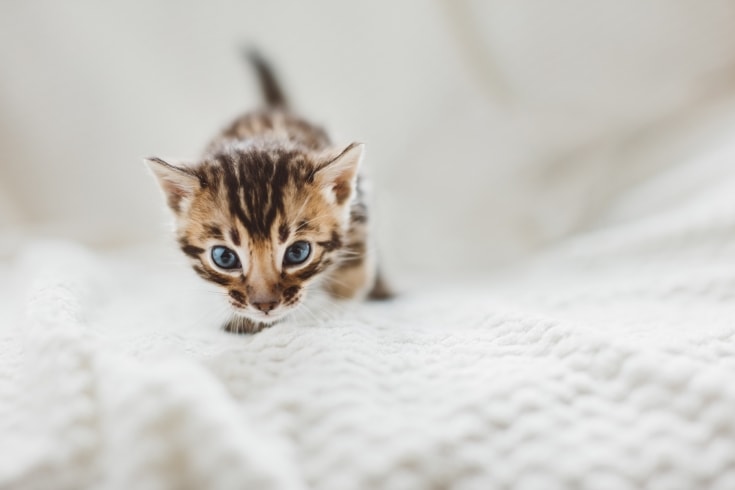
Yes, you can train a kitten.
Actually, kittens learn very quickly. You see, a kitten is like a sponge in that she will willingly and easily soak up new experiences daily. So, the best time to begin training a cat is when she’s a kitten!
What Are The Benefits Of Training Kittens?
Training kittens is important because it gives you the perfect opportunity to establish desirable behaviors from the get-go and stop your pet from developing bad habits, such as scratching furniture or peeing outside her litter box.
Keep reading to learn more about the benefits of training your furry friend from day one!
Develops Good Behavior Habits
Training your kitten from a young age helps to instill positive behaviors and good manners, making your pet a pleasure to have around your home and setting the foundation for a well-behaved and respectful adult cat.
Strengthens Bond Between Kitten And Owner
Training is fabulous for establishing a strong bond between you and your pet! Kittens learn to associate training sessions with positive experiences, such as treats and praise, so they become more attached to their owners and develop a strong bond based on trust and positive reinforcement.
Enhances Mental Stimulation And Enrichment
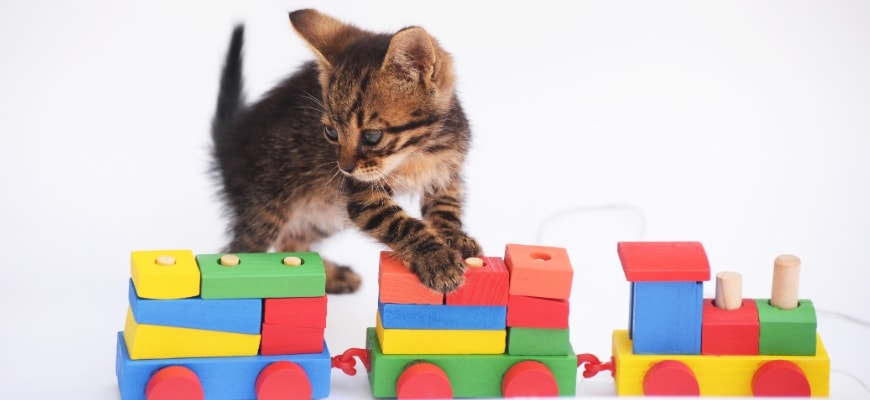
Kittens are fascinated by everything and everybody they meet, but they do get bored easily. Mental stimulation through training exercises challenges your kitten’s cognitive abilities and helps to prevent behavioral issues that often stem from boredom.
Reduces Potential Behavior Problems
Training a kitten from an early age really helps to address and prevent common behavioral problems, such as scratching furniture, aggression, and biting, by providing an alternative way of constructively burning off excess energy.
Fosters Social Skills With Humans And Other Pets
Training your kitten to interact with people and other pets teaches your pet to be socially well-adjusted and confident, which is essential in a multi-pet household.
Encourages Physical Activity And Exercise
Kittens are bundles of energy, and training sessions can get your kitten into the habit of being physically active and exercising. Not only does that help to burn off excess energy that might otherwise be misdirected into bad behaviors, but it can also help promote healthy physical development.
Facilitates Easier Vet Visits
A kitten that is used to being touched and played with will be much less stressed during veterinary visits for regular check-ups and vaccinations, and the vet’s job will be much more pleasant and easier too!
Improves Safety (e.g., Recall Commands)
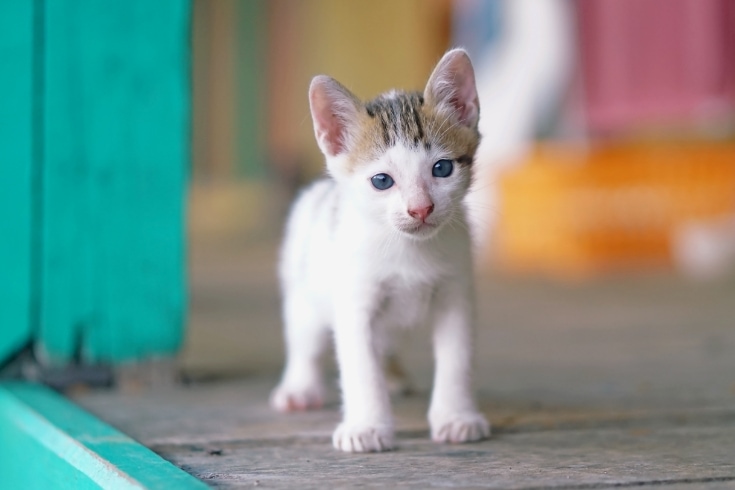
Did you know that around 230,000 cats and kittens are killed on the roads on a daily basis in the UK alone?
Training commands, such as “come” and “stay,” can be life-saving in a dangerous situation when your kitten gets too close to the road or some other potential hazard.
Provides a Structured Environment For Growth
Cats are very much creatures of routine, and consistent training sessions can help create a sense of routine essential for your kitten’s growth and development.
Boosts Confidence In Kittens
When your kitten learns to carry out a simple task or respond correctly to one of your cue words, the praise you give him helps to boost your pet’s confidence, positively influencing her behavior.
Increases Adaptability In Various Situations
Training your kitten exposes her to different people, environments, and scenarios, and that exposure helps your pet to be more adaptable and less stressed in unfamiliar surroundings and situations.
Makes Home Management Easier (e.g., Litter Training)
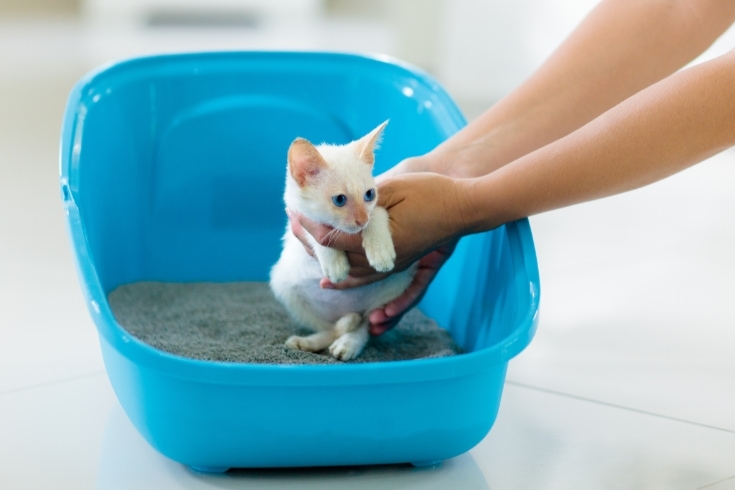
Let’s face it, no one wants to come home to a house that smells of cat pee! Training your kitten to use her litter box is fundamental for a harmonious home and relationship between you and your pet and keeping your home clean and hygienic.
Enhances Communication Between Kitten And Owner
Training your kitten helps to enhance the communication between you and teach you more about your precious pet’s preferences, strengths, and behavioral issues you might need to address.
For example, I learned very early on that one of my kittens did not enjoy treats, preferring playtime with her favorite catnip mouse toy as a reward.
Provides Fun And Engaging Activity For Both Kitten And Owner
Your training sessions should be fun and exciting times for you and your pet! Make no mistake, your kitten will understand when she has done something right, and you will both enjoy a tremendous sense of achievement the first time your cute fluffy bundle sits on command or offers you a high five!
Promotes Better Understanding Of Kitten’s Needs And Behaviors.
As we mentioned earlier, training your kitten gives you valuable insight into how she behaves, her preferences, and the potential challenges you will face. Armed with that knowledge, you can forge ahead to teach your pet to be the best-behaved kitty on the block!
What Are Essential Training Tools For Kittens?
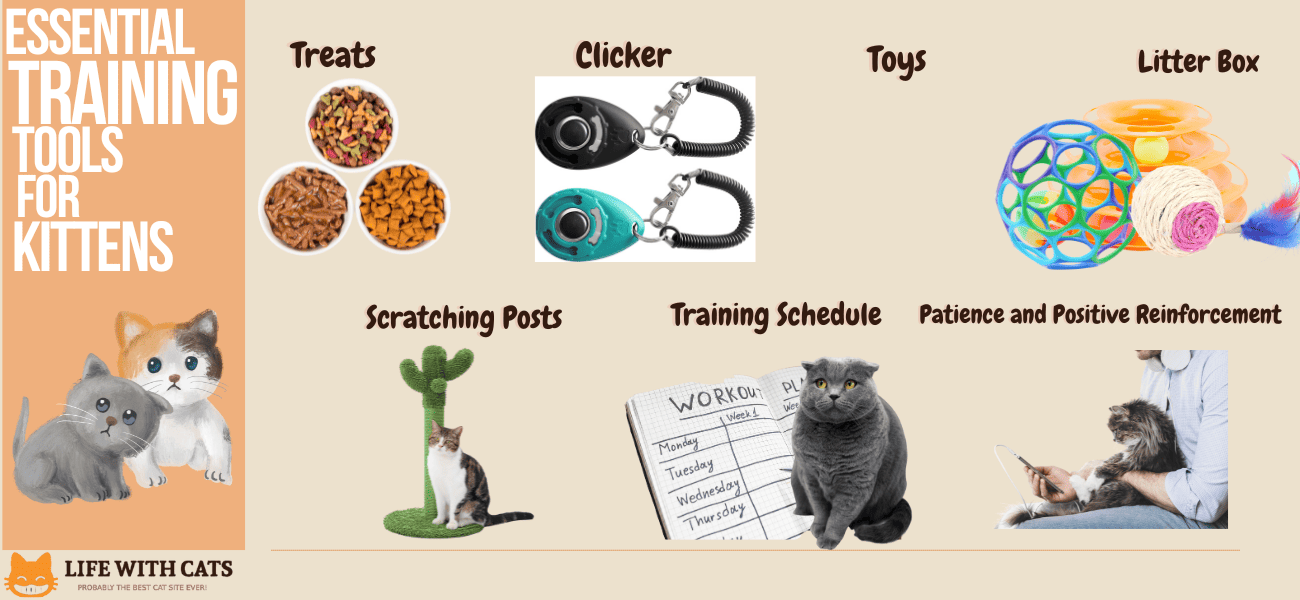
To train your kitten, you’re going to need the following essential training tools, which you can buy from good pet stores and online.
Treats

First of all, you’re going to need some tasty treats to motivate your pet to work hard for her rewards. There are lots of different types of training treats to choose from, including single-ingredient, crunchy, soft, and puree tubes, so you’re sure to find something your kitten loves.
Clicker

A clicker is a small handheld device that makes a clicking sound when you squeeze it. When you ask your kitten to complete a trick or respond to a simple command, you click the clicker, and when your pet does what you want, immediately reward her.
Over time, your cat learns that the clicking sound means she’s done the right thing.
Toys
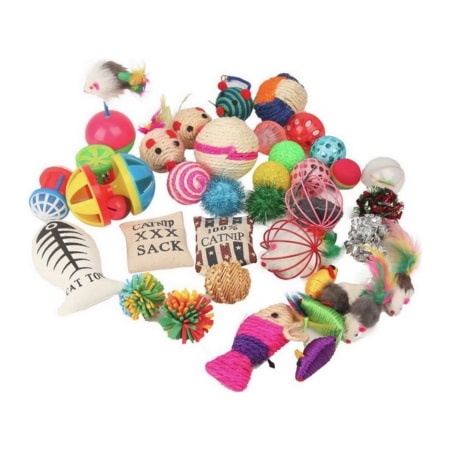
Of course, not all cats, including one of mine, appreciate treats and prefer to be rewarded with playtime and a favorite toy.
So, it’s up to you to figure out what toys float your kitty’s boat and ensure you have plenty available for training sessions.
Some toys can be used as training devices, not just rewards. For example, a target stick is an extremely handy training tool, and puzzle toys can also make excellent interactive training games.
Litter Box

Litter box training is one of your kitten’s first and most important training commands. You can buy covered litter boxes that help prevent spillage, completely enclosed litter boxes with catflaps that provide total privacy for your pet, and traditional open boxes, too.
You might need to experiment to find out what style of litter box your kitten prefers.
Scratching Posts
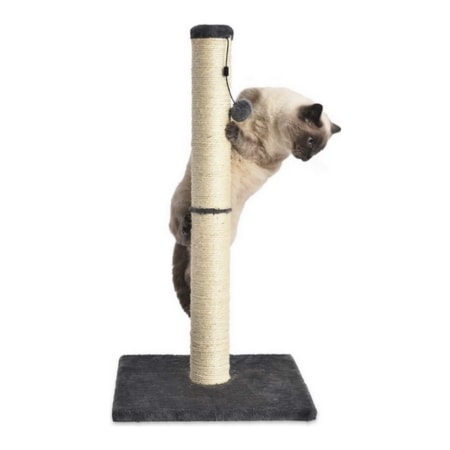
One of the most common complaints new kitten owners make is that their pets use furniture and carpets to sharpen their claws and scratch.
Scratching is a perfectly normal cat behavior that shouldn’t be discouraged, as it keeps the cat’s claws in good condition and acts as a stress reliever and territory marker. A scratching post is an essential training aid that you can use to save your home furnishings and keep your kitten happy!
Training Schedule
Cats are creatures of routine and thrive on a regular training schedule. You can devise your own schedule, starting with the easiest commands and working up to more advanced ones when your kitten is older.
Pick a time for training when your cat is not hungry, expecting to go outside, or feeling sleepy after a night out on the town.
Patience And Positive Reinforcement

The key to successful, happy training is using patience and positive reinforcement in all your training sessions.
Never get frustrated and annoyed with your kitten!
If you yell at your pet, you’ll frighten her, damage the bond you’re working so hard to form, and set back your training efforts.
What Are The Effective Techniques For Training Kittens?
Here are some cat training techniques that can be highly effective in teaching kittens new commands and tricks.
Positive Reinforcement
Positive reinforcement training involves rewarding your kitten with praise and treats when she responds correctly to a command or cue. That way, the kitten learns that the behavior earns her a reward, making it more likely that she’ll repeat the behavior in the future.
Clicker Training
As mentioned above, a clicker is a small, handheld device That makes a clicking sound when you press it or squeeze it. When the cat hears the click, she knows she has done the right thing, and we’ll receive a simultaneous reward.
Lure Training
Lure training is a positive reinforcement-based training method that you use to teach your kitten various desired behaviors and tricks using a lure or target object. The lure is attached to a string or stick, and you use it to guide and motivate your kitten to perform certain actions by moving the lure in specific patterns or directions.
For example, lure training is highly effective for teaching kittens behaviors that might not come naturally to them, such as weaving between poles, performing simple agility exercises, and jumping through hoops.
Target Training
Target training is very similar to lure training in that a short wand or stick with a ball or feather on one end is used to direct the kitten. For example, if you want your kitten to go into her bed, point the target Into the bed and encourage your kitten to follow it.
Socialization
A well-socialized kitten is a pleasure to have around your home, and socialization forms a very important part of every kitten’s training regimen. Socialization involves introducing your kitten to lots of new people, animals, and social situations so that nothing fazes her.
What Are Some Kitten Training Tips?
You can use the following helpful, expert tips to train your kitten successfully.
Understand Kitten Behavior And Communication

Before you begin training your kitten, you need to understand how they communicate and what their different behavior means. Every kitten has her unique way of expressing herself and learning how to tune in to your pet’s body language and vocalizations will help you interpret her needs and responses accurately.
Gather Essential Training Tools (Toys, Treats, Clickers)
So that you can both remain focused on your training session, gather all the essential training tools you’ll need, including treats, clickers, and toys.
Set Up A Safe And Kitten-Friendly Training Environment
Kittens are notorious for getting into mischief and are very easily distracted, so you will need to set up a safe, kitten-friendly training environment for working with your pet. Choose a quiet space in your home where you won’t be disturbed, and is free from things that are likely to distract your pet.
Begin With Simple Commands (Sit, Stay, Come)
Don’t be tempted to plunge your kitten in at the deep end by trying to teach her complicated or advanced commands. Instead, start with simple cues, such as “sit,” “stay,” and “come.” These are all easy commands for your kitten to learn as well as being useful around your home.
Use Positive Reinforcement (Rewards, Praise)
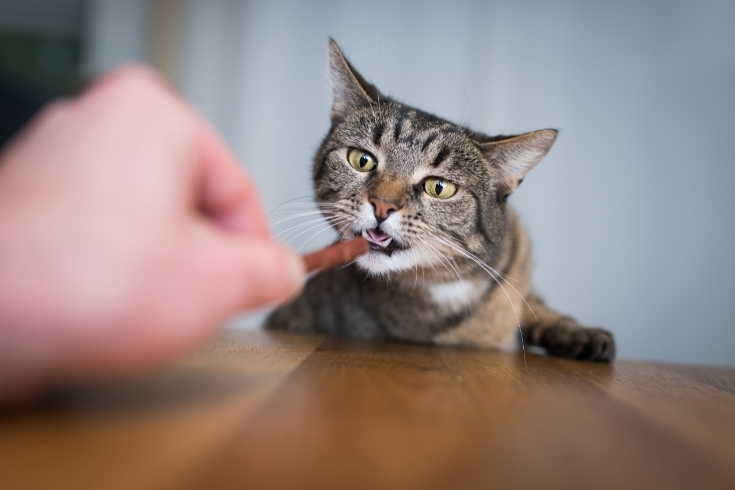
Use positive reinforcement training techniques in all your training sessions with your kitten. Positive reinforcement means rewarding your cat with a treat, praise, and whatever other reward your cat prefers immediately after she displays a desired behavior. That way, your pet learns that she has done the right thing and is more likely to repeat the behavior in the future, hoping to get another reward.
Practice Litter Box Training
I have never owned a kitten or older cat that didn’t understand what her litter box was for! Cats are naturally clean animals that will not pee or poop on your carpets unless there is no nowhere else for them to go.
However, you can reinforce proper litter box habits early on by placing the litter box in a quiet, accessible location and gently pointing your kitten in the direction of the box after meals and naps. When your furbaby uses the litter box correctly, praise and reward her.
Teach Kitten To Use A Scratching Post
Direct your kitten’s natural scratching instincts toward a designated scratching post or mat and encourage them to use it by scattering treats close to the scratching post and offering positive reinforcement whenever your pet uses it.
Start Leash Training
Training your kitten to walk on a harness and leash is incredibly useful if you live close to a busy road or you plan on keeping your pet indoors all the time. Use a lightweight harness designed for kittens, and allow your pet to get used to the sensation of wearing it indoors before you take her outside.
Teach Bite Inhibition
Nobody wants to be the owner of a cat that bites, so start teaching your kitten to play gently and not to bite hard. When your kitten bites you, try making a high-pitched yelp and immediately withdrawing attention from your pet to discourage the behavior.
Discourage Inappropriate Climbing
Although climbing is perfectly natural for kittens, you don’t want your pet scrambling up your furniture or drapes, potentially ruining them. Use deterrents, such as aluminum foil or double-sided tape, on surfaces you don’t want your kitten to climb on, and provide her with suitable climbing alternatives.
Train For Quiet Time And Proper Sleep
Kittens are extremely active, which can be exhausting, especially if you work at home. I trained both my kittens to take a break and have a nap immediately after a training session as part of their daily routine. That way, my kitties were well-rested, and I got to enjoy some peace and quiet, enabling me to work without distractions for a couple of hours!
Progress To More Advanced Commands And Tricks
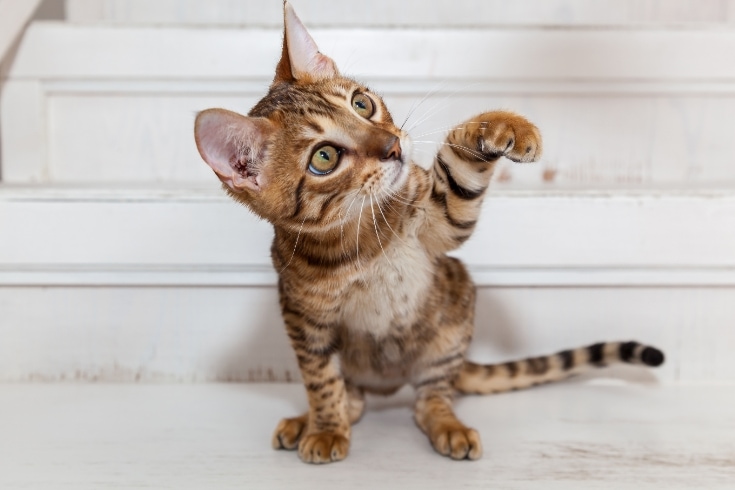
Once your kitten has mastered basic commands and skills, you can challenge her with more advanced ones and teach her some fun tricks. That helps keep your pet’s mind engaged and deepens your bond.
Regularly Review And Reinforce Learned Behaviors
Once your kitten has learned a few tricks and commands, it’s essential to keep revisiting them so that she doesn’t forget. I find it helpful to ask my cat to perform a simple trick he knows well at the end of a difficult training session where we’ve been working on more advanced stuff. That way, we always end on a positive note.
Address Behavioral Issues Promptly And Correctly
Occasionally, behavioral issues will arise, and it’s important to address them promptly by using positive reinforcement and redirection.
Do not punish your kitten, as that will destroy the trust and bond you are building between you.
Maintain Patience And Consistency Throughout Training
Training a kitten takes time and patience, and you must be consistent in your commands, rewards, and routines so that you don’t confuse your pet and reinforce learning.
Regularly Visit The Vet For Check-Ups And Advice
Throughout the first few months of your kitten’s life, you will need to regularly visit the vet for check-ups, vaccination boosters, and advice. You can also take the opportunity to mention any training issues you’re having with your pet, as the vet will be able to advise you on them.
Adjust Training As Kitten Grows And Develops
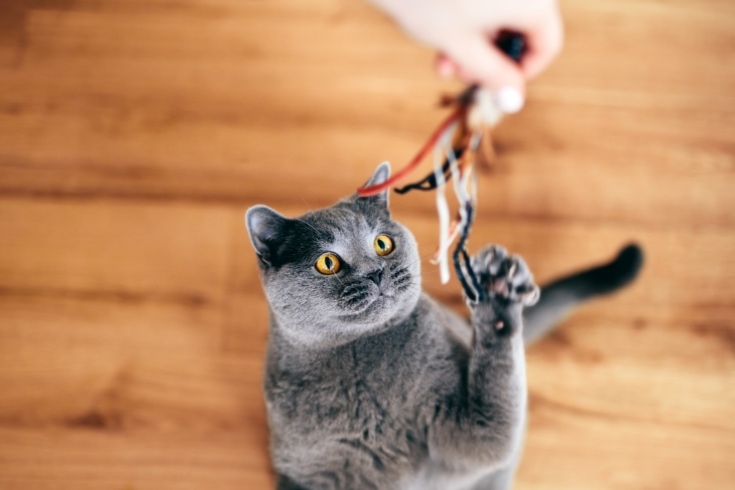
Hopefully, your kitten will grow and develop quickly throughout the training process, so you must be ready to adjust your approach in line with your pet’s development.
Use Playtime As Part Of Training
Training should be a fun part of your kitten’s day, so use playtime to break up each session into bite-sized chunks to prevent boredom and keep the experience positive for your pet.
Ensure Proper Nutrition And Health During Training
A well-fed, healthy kitten is more receptive to training than a hungry, sickly one, so be sure to feed your kitten a correct and well-balanced diet and keep up with regular veterinary check-ups.
Regularly Monitor Kitten’s Progress And Adapt Training Accordingly
Throughout your pet’s training during kittenhood and as an adult, regularly monitor her progress and adapt your training accordingly. Be prepared to accept that there will be setbacks, and remember to be patient and prepared to take a step or two back if that’s what your cat needs.
What Are The Things I Can Train My Kitten To Do?
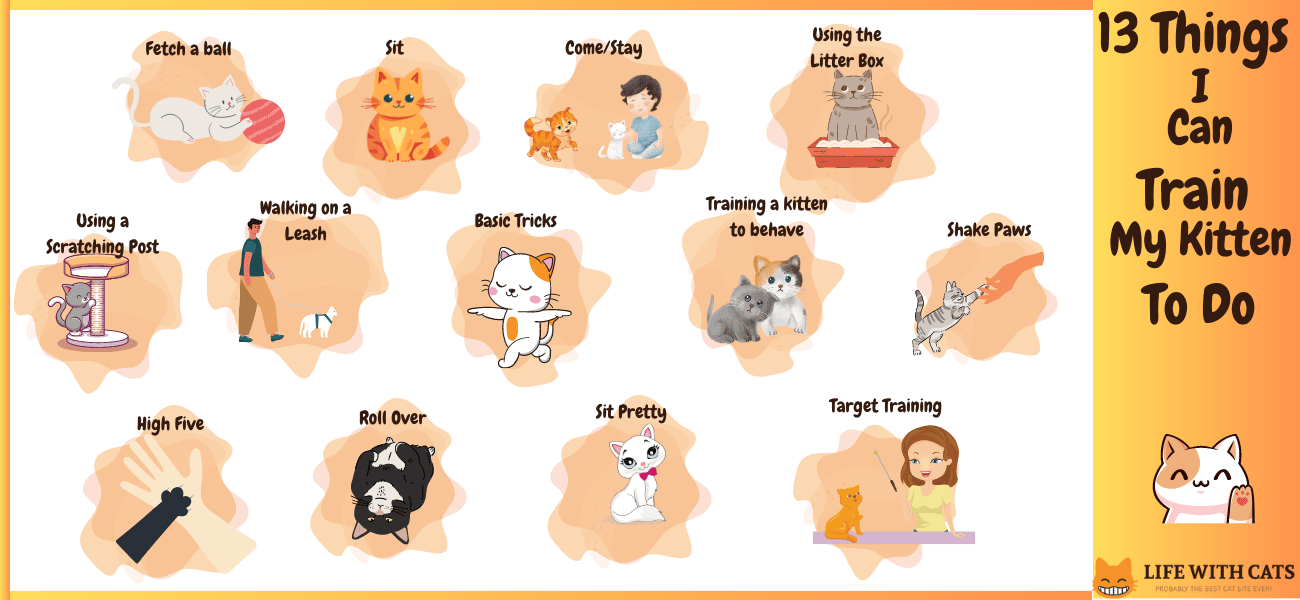
You can train your kitten to do lots of different behaviors and even a few clever tricks, including fetching a toy, sitting and staying on command, and using a scratching post. So check out all these clever tricks and commands and get started training your pet!
Fetch A Ball
This trick involves teaching your kitten to fetch a ball and bring it to you. Choose your kitten’s favorite lightweight ball that’s easy for her to pick up and carry.
- Begin playing with the ball near your kitten and encourage her to join in.
- Now, roll the ball a short distance away from you and encourage your kitten to go to it.
- When your kitten touches or picks up the ball, praise her and reward her with a treat.
- Next, encourage your kitten to fetch the ball for you. Use a simple cue word, such as “fetch!”
- When your kitten fetches the ball to you, reward her with a high-value treat or play with her favorite ball. That positive reinforcement makes your kitten more likely to repeat the behavior.
- Try extending the distance that you throw the ball, remembering to reward your kitten when she brings the ball to you.
Sit
Teaching your kitten to sit is a basic command that’s pretty easy to teach.
- Hold a tasty treat in your hand and let your kitten sniff it.
- Slowly lift the treat above your kitten’s head toward her back, keeping the tempting morsel just out of reach.
- The kitten will automatically follow the treat with her eyes, causing her to sit down.
- As you move the treat, tell your kitten to “Sit” so that she associates the cue word with the action.
- Immediately, your kitten sits, give her verbal praise, and present her with the treat as a reward.
- Repeat the exercise, then use the command word without the aid of the treat. Eventually, your kitten will sit on command.
Come/Stay
The next trick to try teaching your kitten is to come to you and then stay put.
Assuming your kitten knows her name, you should only need to call out to her and offer her a treat, and lots of fuss when she comes to you. That’s how I taught my kittens to come when called, and the promise of a tasty snack and my attention works every time!
So, now you must teach your kitten to stay, which is the trickiest part of this command.
- Start by asking your kitten to stay in a certain spot for a few seconds, and reward her when she does. Repeat the exercise a few times until the penny drops.
- Gradually increase the duration and distance of the stay. As you give the verbal command, take a step backward. If your kitten stays in place, praise her and give her a treat.
Using The Litter Box
Most kittens and mature cats will use a litter box in preference to going anywhere else in your home. That said, I had one kitten that was the exception to that rule. Rather than using his perfectly prepared new litter box, Gatsby insisted on relieving himself in my pot plants!
At first, I didn’t understand what the problem was, but then I realized that the kitten had been a stray, so he was used to going to the bathroom in flowerbeds. The little guy didn’t understand what the gravel cat litter was for, but the soil in the plant pots was just like his usual toilet! I quickly solved the problem by scattering some earth over the cat litter in the box, and, bingo, Gatsby immediately began using it.
- Place the litter box somewhere quiet and sheltered where your kitten will have privacy and won’t be disturbed.
- Kittens generally relieve themselves immediately after a nap or a meal, so be ready to guide your pet to the litter box at those times and have a treat ready as a reward when your pet uses the box.
Using A Scratching Post
You can prevent damage to your furniture and provide a natural stress reliever for your pet by training her to use a scratching post.
Choose a post mounted in a firm base that won’t fall over when your kitten uses it, and put the scratching post adjacent to a place where your kitten tends to scratch.
- Scatter some treats around the base of the post or sprinkle it with catnip to encourage your kitten to investigate. As soon as your kitten approaches the scratching post, praise and reward.
- To keep your kitten interested and make her more inclined to use the scratching post, regularly scatter some catnip and treats around the base of the post. Eventually, your pet will use the scratching post in preference to your furniture and carpets!
If you catch your kitten scratching where she shouldn’t, immediately tell her ”No!” in a firm voice, and guide her to the scratching post.
Walking On A Leash
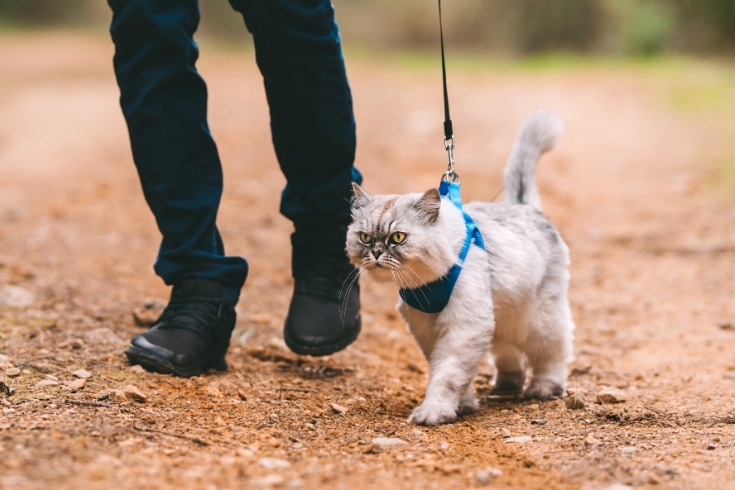
Teaching your kitten to walk on a harness and leash is handy if you want to give your pet a taste of the Great Outdoors without risking her getting into heavy traffic or getting lost.
- Buy a kitten-specific harness and a lightweight cat leash and ensure it fits your pet properly. I advise you not to use a collar and leash, as that could tug on your cat’s neck if she pulls back, potentially causing injury.
- Fit the harness and allow your kitten to get accustomed to it, using treats and affection to praise and reassure her.
- Fix the leash to the harness and let the kitten explore inside your home, dragging the leash behind her.
- Encourage your kitten to walk on the leash, encouraging and tempting her with treats, toys, and a lure. Rewarding your kitty when she walks beside you and ignoring any resistance.
- Next, try walking your kitten in a small enclosed outdoor area. Let your kitten sniff around and experience the strange sights and sounds, rewarding and reassuring her as you go.
- Walking on a harness and leash is a difficult concept for your kitten to get her head around, so be patient, and allow your pet all the time she needs to gain her confidence and trust in you.
Basic Tricks
It is possible to teach a kitten a few basic tricks using positive reinforcement, patience, and time. Here’s a guide on how to teach tricks that are simple for your kitten to learn and fun to work on together.
Training A Kitten To Behave
Understanding how to train a kitten to behave is pretty straightforward.
- First of all, you need to identify the undesirable behavior the kitten is exhibiting, for example, scratching the furniture.
- Now, use positive reinforcement techniques to guide the kitten and show her what behavior is acceptable as an alternative.
- Remember to offer your kitten plenty of rewards and praise throughout training.
Shake Paws
In this trick, you can teach your kitten how to shake hands with you on request. We think tricks don’t get much cuter than a kitten offering to shake a paw!
- Start by picking up your kitten’s paw and giving her a treat. You will probably need to repeat this process several times over several training sessions until your kitten is confident and comfortable with touching her paws.
- Now, offer your hand to your kitten, hold your palm upward, and gently touch her paw. at the same time, use a cue word, such as ”paw” or “shake hands.”
- The second your kitten offers you her paw, say your cue word and give her a treat. Next, use the cue word and offer your kitten your hand to shake.
- Gradually, stop treating your kitten every time she performs the trick, but carry on praising her and reinforce the behavior occasionally to keep your pet motivated and interested.
High Five
The high-five trick asks your kitten to sit and raise her paw to touch your opposite hand.
- Offer your kitten a target stick and let her sniff it. Give your pet a reward so that she associates the target with a positive experience.
- Now, offer the target to your kitten, and reward her with a treat when she touches it. Keep repeating the process until your pet associates the target with receiving treats.
- Now, start raising your hand for the kitten to touch. Present the target stick and lift your hand simultaneously.
- Reward her immediately when your kitten touches the target in response to the high-five hand signal.
- Over time, you can remove the target stick so that your kitten responds to the high-five cue alone.
Roll Over
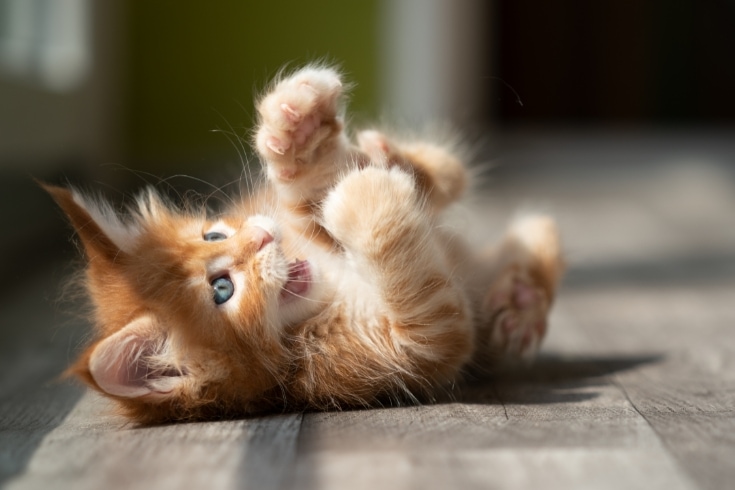
If your kitten rolls over on command, grooming her will be much easier, making checking for ticks and fleas much simpler.
- Have your kitten lying on the floor with lots of free space around her and kneel beside her.
- Start petting your kitten, and she will probably lean toward you and rub her face against your hand. Now, reach over your pet to her other side and rub your hand on the ground. Your kitten will likely roll to your hand hoping to get more attention.
- Repeat the process the other way around so that your kitten rolls over again to face you. At the same time, give a verbal cue, such as “roll over,” and reward your kitten with a treat and lots of praise.
- With practice, your kitten will roll over on cue to get more fuss and treats from you.
Sit Pretty
“Sitting pretty” is when your kitten sits up on her hind legs with her front paws raised in a super cute begging pose.
- To learn this trick, your kitten must be familiar and confident with basic commands like “sit” and “stay.”
- Start by asking your kitten to sit, and reward her with a treat when she does so.
- Choose a hand signal to accompany your “sit” command, such as raising your hand slightly with your palm facing upward.
- With your kitten sitting down, hold a treat close to her nose and slowly raise it upward. That naturally encourages your kitten to lift her front paws and reach out for the treat.
- As your kitten raises her paws, use your hand signal and ask her to ”sit pretty.”
This trick is deceptively easy to teach since you’re already halfway there if your kitten already understands the “sit” command.
Target Training
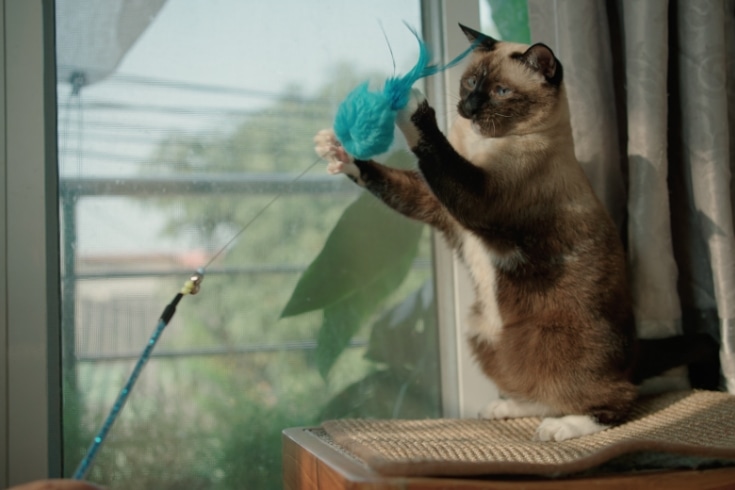
Target training is essential for many other cat tricks, so teaching it to your kitten early in her training program makes sense.
- Hold your target stick in front of your kitten a few inches from her nose. When your kitten touches the ball on the end of the target stick, give her a treat and lots of praise.
- Keep repeating the exercise until your kitten touches the target stick every time it’s presented to her.
- Move the stick further away from your kitten an inch at a time, and start moving the stick in different directions, rewarding your pet every time she touches the target.
What Are Some Frequently Asked Questions About Training A Kitten?
In this part of our comprehensive guide, you’ll find the answers to a few of the most frequently asked questions about training a kitten. Of course, if you have any other kitten training questions for us, please ask them using the comments box below!
When Do You Start Litter Training Kittens?
You can begin litter training kittens from around three to four weeks of age when they begin to develop the ability to control their bladder and bowel and can begin using a litter box.
Use a shallow litter box with non-clumping, unscented cat litter, and place it in a quiet, easily accessible spot. After meals and naps, the kittens will most likely want to relieve themselves, so gently placed them in the litter box.
Be patient and consistent, quick to reward and praise the kittens, and they should catch on pretty quickly.
Do Kittens Know Their Name?
Kittens generally get to know their names pretty quickly. When I got my two kittens, I was always talking to them, and I made a point of using their names when feeding, petting, and training them.
How long it takes for your kitten to know her name really depends on the individual because some kitties catch on more quickly than others. however, I would expect a kitten to know its name within a couple of weeks.
How Long Does It Take To Train A Kitten?
Many factors affect the time it takes to train a kitten, including the kitten’s age, temperament, and what type of training you are attempting.
However, basic training behaviors, such as litter box training, responding to her name, and gentle handling, can all be established in a matter of weeks. When it comes to training your kitten to respond to basic obedience commands and simple tricks, that can take a few months of patient, consistent training.
What Should I Do If My Kitten Is Not Responding To Training?
If your kitten is not responding to training, there are a few things you can do.
- Your first action should be to ask your vet to check your kitten for potential health issues that could affect her ability to respond to training.
- Kittens have short attention spans, so be patient and consistent, and be sure to keep your training sessions short and fun.
- Make sure that you’re using the same cues, rewards, and methods during your training sessions, as inconsistency can be extremely confusing for kittens.
- Use positive reinforcement training methods, including treats, playtimes, and lots of praise as rewards for desired behaviors.
- Do not punish your kitten if she seems slow to catch on to your training; every cat is different, and some learn more quickly than others.
- Ensure your training area is free from distractions, quiet, warm, and comfortable.
- Some kittens respond better to certain training techniques than others, so learn what motivates and engages your kitten the most and use that to your advantage when training her.
- If you’re struggling and your kitten seems unresponsive to your training, it’s worth chatting with a vet or a professional animal trainer who can provide guidance and training advice to help you and your pet.
Above all, make sure that your training sessions are enjoyable and fun-packed and always finish on a positive note.
Conclusion
Training your kitten means teaching your pet to learn desirable behaviors, strengthening the bond between you, and making your cat more fun to have around your home.
As you’ve learned, several training methods work well with kittens, including positive reinforcement training, repetition, and reward-based training. Kittens are quick to learn, and with the help of a few simple training tools, such as treats, clickers, and a target stick, you can soon train your kitten to perform simple tricks, learn desired behaviors, and correct undesirable ones.
Owning a kitten is an exciting, fun experience that can light up your life! And that experience can be made even better and more satisfying if you get into training your new furry friend so that she grows into a well-mannered, sociable, respectful adult cat who’s a pleasure to have around.